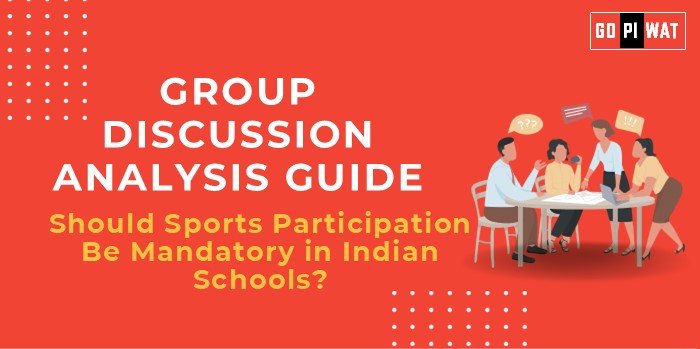📋 Group Discussion (GD) Analysis Guide
🏫 Should Sports Participation Be Mandatory in Indian Schools?
🌟 Introduction to the Topic
- 📜 Context: With rising concerns over sedentary lifestyles and mental health among students, making sports participation mandatory in Indian schools has sparked a nationwide debate.
- 📖 Background: The New Education Policy (NEP) 2020 emphasizes holistic development, including sports. This proposition aims to tackle issues like childhood obesity, stress, and lack of teamwork skills while promoting a balanced education system.
📊 Quick Facts and Key Statistics
- ⚕️ Child Obesity Rates: 14.4% of Indian children aged 5-19 are obese (WHO 2023), highlighting the need for physical activity.
- 📉 Dropout Rate Reduction: Schools with active sports programs saw a 20% decrease in dropout rates (NCERT 2022).
- 🧠 Mental Health Benefits: Regular sports participation reduces anxiety in 75% of students (AIIMS Report 2023).
- 🌍 Global Benchmark: In Japan, 99% of schools mandate physical education, fostering discipline and teamwork.
🤝 Stakeholders and Their Roles
- 🏛️ Government: Formulating policies, funding sports infrastructure, and providing teacher training.
- 🏫 Schools: Implementing structured programs and ensuring participation.
- 👨👩👧👦 Parents: Encouraging and supporting extracurricular involvement.
- 🎓 Students: Embracing physical education as part of holistic development.
🎯 Achievements and Challenges
✨ Achievements
- 📚 Improved Academic Performance: Studies link physical activity to higher cognitive function.
- 🤝 Inclusive Growth: Sports foster teamwork among diverse groups.
- ⚕️ Health Improvements: Reduction in obesity and associated diseases.
⚠️ Challenges
- 🌐 Infrastructure Gaps: 60% of Indian schools lack playgrounds (UNICEF 2023).
- 📖 Cultural Resistance: Academic pressure often sidelines sports.
- 💸 Funding Constraints: Limited budgets for sports equipment and facilities.
Global Comparisons:
- 🇺🇸 USA: “No Child Left Behind” integrates sports into public education.
- 🇫🇮 Finland: Balanced schedules with compulsory physical education ensure well-rounded growth.
🗣️ Structured Arguments for Discussion
- 📈 Supporting Stance: “Mandatory sports participation will address the dual crises of poor physical health and rising mental stress among students.”
- ⚖️ Opposing Stance: “With limited resources, prioritizing academics over sports may be more practical for schools in rural areas.”
- 💡 Balanced Perspective: “Mandatory sports should be introduced in phases, prioritizing schools with sufficient infrastructure.”
💬 Effective Discussion Approaches
- 📌 Opening Approaches:
- Cite rising health issues among children to set the stage.
- Highlight NEP 2020’s focus on holistic development.
- 🔄 Counter-Argument Handling:
- Rebut “resource constraints” by emphasizing partnerships with local communities or NGOs.
- Address academic concerns by citing research linking sports to better focus and academic results.
📈 Strategic Analysis of Strengths and Weaknesses
Strengths:
- ⚕️ Improved health outcomes among children.
- 🤝 Development of teamwork and leadership skills.
- 📚 Enhanced academic performance through physical activity.
Weaknesses:
- 🌐 Infrastructure limitations in rural areas.
- 📖 Resistance from traditional education models focusing on academics.
Opportunities:
- 🎓 Growth in sports-related careers.
- 🤝 Partnerships with sports organizations and NGOs for infrastructure development.
Threats:
- 🏆 Risk of overemphasis on competition, potentially neglecting inclusivity.
- 📖 Fear of academics being sidelined in favor of sports.
🏫 Connecting with B-School Applications
- 📚 Real-World Applications:
- Topics like operational challenges in resource management or organizational behavior in team sports.
- 🎓 Sample Interview Questions:
- “What are the long-term impacts of mandatory sports in education?”
- “Can sports foster leadership skills among students?”
- 💡 Insights for B-School Students:
- Consider sports as a model for team-building and strategic planning.


